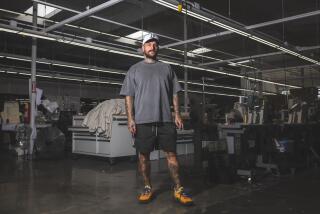Getting Sneaker Maker Converse Back on Its Feet
NORTH READING, Mass. — For more than half a century, Chuck Taylor All-Star sneakers--canvas, with a trademark star logo--ruled every schoolyard, high school, college and pro basketball court in America.
But Converse Inc., the company that invented basketball shoes, continues to struggle under a full-court press of problems.
Since January, the company has sought bankruptcy protection, closed three North American factories and moved production to Asia. It then was sold at auction for $117.5 million to cover debts.
Chuck Taylors, once worn by 70% to 80% of hoops players, are now more often seen on counterculture teenagers and baby boomers. Converse’s basketball shoes, meanwhile, account for only about 2% of athletic footwear sales.
New Chief Executive Jack Boys said there’s room for Converse in a world dominated by Nike Inc. and Reebok International Inc.
“We’re not going to go against them,” said Boys, a former Converse sales executive who later headed worldwide marketing at outdoor apparel maker North Face Inc. “We’re going to really carve a niche that allows Converse to be Converse.”
The task falls on a new Converse, whose 180 employees are a far cry from the 2,000-plus just two years ago. The company feels more like a start-up than a 93-year-old brand, Boys said, and in a way it is: Its new owners bought only the valuable Converse brand and none of the old company’s debts.
Investors Marsden Cason and William Simon, through their company Footwear Acquisition, saw an opportunity in the Converse name.
“The prior business, it was really operational and financial issues they had,” Boys said. “The brand had stayed strong in the marketplace, and they continued to make some good products.”
Experts agree that the Converse name is still well known. It’s just a question of whether the new company can make the products to back it up.
“Whatever the history of the company is, the brand name is just tremendously powerful,” said Thomas Doyle, vice president of information and research at the National Sporting Goods Assn. “It’s always been associated with basketball.”
The old Converse was a victim of self-inflicted wounds and large-scale industry changes, experts say.
Its rubber-toed shoes started fading in the 1970s, and by the 1980s, athletic shoes were turning into small machines packed with pumps and gases and gels. Converse couldn’t keep up with the new technologies or the marketing dollars behind them.
But there also was bad luck. Nike signed Michael Jordan, whose court skills and appealing image brought the company fame and fortune. Converse signed Latrell Sprewell, who had to be dropped after he tried to choke his coach.
Last year, sales were just $145 million, and by the time it declared bankruptcy in January, the company had lost more than $100 million.
Though some pro athletes still wear Converse shoes, the company isn’t paying anyone to wear them. Boys says said Converse might look for superstar athletes to sign, but might decide it doesn’t need to.
“When Converse originally had all these players in the NBA, colleges and high schools, we weren’t paying,” he said. “They were buying this because it was the premium brand for your feet.
“That’s our internal goal, to have these shoes be so good that it’s the athletes’ shoe of choice.”
More to Read
Inside the business of entertainment
The Wide Shot brings you news, analysis and insights on everything from streaming wars to production — and what it all means for the future.
You may occasionally receive promotional content from the Los Angeles Times.










